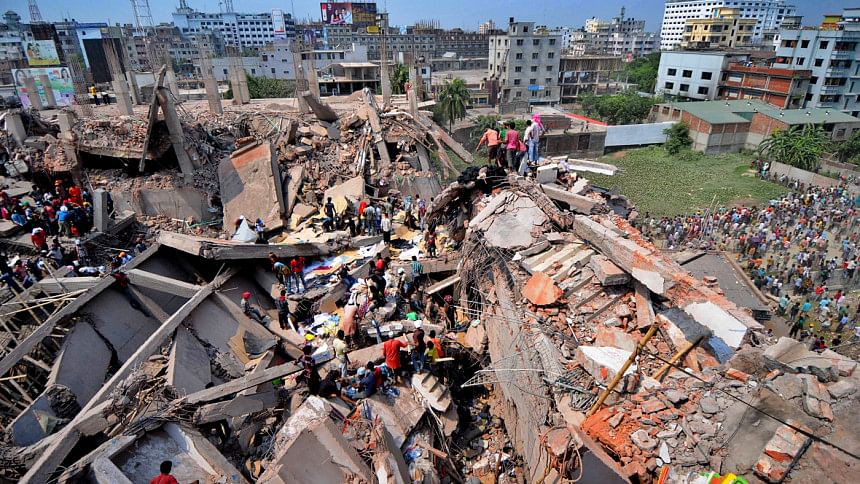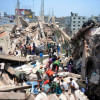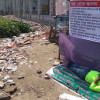Fourth Anniversary Of The Rana Plaza Collapse: Where do we stand?

It has been four years since the day in April when the nation and the world was shocked when a garment factory building in Savar came crashing down. 1,129 workers were killed and thousands more injured, trapped in the rubble. Not the first time but definitely the largest incident of accidental structural failure that brought to the limelight the issues of building safety, workers' rights and the problems in the global supply chain. Four years down the line, where do we stand?
The Daily Star talks to three experts - a researcher, a labour activist and a development professional - about the progress Bangladesh has made and the challenges it still faces.
Khondaker Golam Moazzem
Research Director, Centre for Policy Dialogue (CPD)

Compensation
What we have seen is, the immediate issues, particularly the ones involving the victims – supports, training, compensation, treatment – had been, from the context of Bangladesh, substantially achieved. But a few challenges remain: some of the immediate issues had short-term and medium-term effects. For example, it was said that the compensation would be determined based on the extent of the injury. But it was not adequate because of the process of calculation and the nature of the problems. They did not get the money in one go; so they had no capital to save and build on.
The biggest gap that remains now is the treatment of injured workers. Some victims are still in need of psycho-social therapy and other treatments. They did not get properly compensated, and so they are today dependent on their families. We had a suggestion then that such victims should be given a card so that they can get support from clinics and hospitals in their localities. The government did not go that way. There should be more fund flow towards these places so that the workers get free treatment.
In 2015 a compensation reassessment was done and supports were provided to some of the victims. But, some cases still remain unaddressed. So, even if our immediate and short-term responses were good, some long-term challenges remain.
"Globally, Rana Plaza symbolises a system of change that needs to be developed within the value chain, particularly RMG. It started off as a reactive mode, but it gradually turned proactive. But there are weaknesses, and the biggest test for measuring our proactiveness will be when Accord and Alliance will leave and national authority will start looking over the process.
Legal reforms
The short- to medium-term commitments from the government were to address the legal issues. We saw the immediate amendment of the labour law. But then it took two years to issue the rules. We appreciated the law, but different controversies remained in terms of the issuing of the rules. Particularly, till now there has been no concrete position when it comes to workers' rights and trade unions in the EPZs. The government, under pressure after the Ashulia incident, is rethinking these things.
Compliance issues for factories
The issues of the National Tripartite Action Plan are supposed to be enforced at all levels. The safety issues for factories outside Accord and Alliance are supposed to be seen by the national initiative. About 52 percent factories are outside Accord or Alliance. Under this, inspection of 1,500 factories has been completed with the support of ILO. But corrective action plans of these factories have not been approved yet.
It is estimated there are about 700 or 800 factories which are not even included in the national initiative. These are outside the whole inspection process or not fully monitored. These factories are mostly small, subcontracting types. They don't have the investment which will be required for remediation. The challenge is, to sustain these factories, the remediation costs have to be supported through subsidies. On the other hand, if they are not dealt with, in case of any incidents of casualties, the full blame will fall on the entire process.
Changes in labour rights situation
Firstly, the number of trade unions in the factories four years ago was insignificant. There were about 100 factory level trade unions. After the law amendment, the process has been made easier. In the last four years about 500 new trade unions have been registered. So this is a positive aspect.
Now, are those really functional? Most of them are not being able to function properly. Some have been closed, due to factory closures, some are barely there, and only a few are being able to do some work. In recent times, the registration of trade unions has declined as well. We want to see that the registration process keeps functioning. For example, it might be said that signatures did not match, so the registration will not be made – in cases such as these, the facilitating role of the department of labour needs to be made more effective.
Minimum wage
The minimum wage was revised, making it Tk 5,300 from 3,000 in grade 7, which was a good step. Our calculations in 2013 show that even for a partly living wage, workers would have had to be paid Tk 8,200 for grade 7 workers. But because they get overtime benefits, production bonus, allowances, the total amount for grade 3 or 4 workers is around Tk 7,000 plus. This is lower for lower grade workers. But still this is not adequate. My observation is, the living standards of workers have improved a little. Still there is requirement for wage revision.
There is procedural flaw in our method of wage calculation. The family concept is not taken into account. A part of wages should be saved – which is not currently taken into account. There is no national benchmark data regarding wages. So, anecdotal discussions are used. Future wage calculation should be done based on the ILO living wage conditions.
Reforms – reactive or proactive?
It did start as a face-saving reaction. But gradually it has been found to be an effective tool. There is a gradual growing of an institutional element in this. Globally, Rana Plaza symbolises a system of change that needs to be developed within the value chain, particularly RMG. It started off as a reactive mode, but it gradually turned proactive. But there are weaknesses, and the biggest test for measuring our proactiveness will be when Accord and Alliance will leave and national authority will start looking over the process.
Closing the gap
There have been some cosmetic changes in labour related policies, but in terms of effectiveness, there remains a gap. If the work only happens when there is a crisis, then a safety, security infrastructure might be put in place, but there will be little internal industrial relation changes.
Another issue, which is not clear yet, is the role of the global players in the governance and supply chain management. How they can be more engaged in protecting labour rights in the supply chain, ensuring proper wages, and pressure to reduce costs, how to hold them accountable, global guidelines – these need to be strengthened. Global standards need to be set, so that they are not only for Bangladesh, but other supplying countries. There needs to be harmonisation of the standards to be followed by the buyers.
Kalpona Akter
Executive Director, Bangladesh Centre for Worker Solidarity

Inadequate compensation
The compensation given to the victims of Rana Plaza has remained inadequate. They received around USD 30 million from the buyers which is quite satisfactory. But they did not get anything from the owners of the five factories that were housed in that building. There is also a question about the Prime Minister's fund for Rana Plaza victims, and we do not how it was used.
There were gaps in the need assessment of Rana Plaza victims. At that time many workers could not describe their physical problems in detail and the authorities also failed to assess their physical condition properly. Various types of health complications developed later and now the workers are seriously suffering from these problems but they do not have money for treatment. A large number of them are still suffering from trauma. They fear working in a factory environment. Different organisations provided counselling support to the survivors but it was haphazard and inadequate.

The survey done by ActionAid reveals that over 42 percent of the Rana Plaza survivors are still jobless. Though garment owners often say that they are eager to employ Rana Plaza survivors in most cases when these survivors approached garment factories they were denied jobs.
Trade union rights
After the Rana Plaza collapse we saw a sudden rise in registration of trade unions mainly due to international pressure. The number of registered trade unions rose to 400-500 from 146. It is important to consider that among the 146 trade unions only 20-30 were functional. At present though the number is quite big only a handful are active. Among the 500 trade unions, 100 were closed immediately following the closing down of the factories. A large number of trade unions are also formed by factory management which cannot be termed a trade union in the proper sense. These are known as pocket or yellow trade unions.
"The working condition in factories is so harmful that average working year of female workers has gone down from 8-9 years to 4-5 years. The workers usually suffer from diseases such as tuberculosis, silicosis and so on. The nature of the work creates huge pressure on the spinal cord which often turns into fatal disabilities. Reproductive health related issues of the female workers also get little attention.
Among the rest only 50 trade unions are functioning though with various difficulties. This problem has not been properly addressed by the Labour Act 2013 and subsequent rules issued in 2015. In the rules there are certain clauses that go against the interest of the workers. I want to point towards the 55Ka clause which is in a way detrimental to formation of a trade union. It has complicated the registration process. It asks for many documents from the workers which is very difficult for them to provide. On top of it the authorities visit the factory and ask workers about their participation in a trade union in front of the factory management. As a result the workers are often targeted by the factory management. Factory management in collusion with local political cadres often intimidates and harasses the workers for their involvement in trade unions. Unfortunately, there has not been much improvement in ensuring the workers' rights to association though there is a lot of hype about it.
Occupational health and safety
Some measures have been taken to improve the fire and constructional safety of the factory. But the issues of workers' health and occupation safety have remained largely unaddressed. The working condition in factories is so harmful that average working year of female workers has gone down from 8-9 years to 4-5 years. The workers usually suffer from diseases such as tuberculosis, silicosis and so on. The nature of the work creates huge pressure on the spinal cord which often turns into fatal disabilities. Reproductive health related issues of the female workers also get little attention. Most female workers cannot afford proper sanitary facilities during menstruation. The washrooms of the factories are also very unhealthy for the workers.
Living wage
Under the current minimum wage structure it is really difficult for the workers to lead a decent life. We are proposing a living wage structure which will include cost of housing, nutritious food, cost of schooling of their children along with other basic requirements.
Rob Wayss
Executive Director of Accord on Fire and Building Safety in Bangladesh (ACCORD)

Progress after four years
We have made significant progress, but we are behind schedule – I would say we are significantly behind schedule. We have inspected around 1,750 factories over three and a half years. We have conducted, in addition to those, inspection regarding fire, electric and structure; we have conducted 18,000 follow-up inspections. We are at about 75 percent of the safety hazards that were identified in those initial inspections being fixed. It varies factory to factory though – some are around 60 percent, some have finished everything. The global unions and the Bangladeshi IndustriALL affiliates have also done a lot of work with their unions and workers to get information to us about whether things are getting fixed or unsafe conditions persist and letting us know if there are urgent safety concerns so that we can send our engineers on emergency inspections.
But we are way behind schedule. Some of the factories were inspected in 2014 or early 2015 and 95 percent of the remediation should have been completed within six months. So it's almost four years later, and many of the companies are 60-65 percent remediated when it should have frankly been completed.
Unnecessary delays
I think the most prominent one is that the factories just delayed in doing the remediation and made excuses about why they couldn't do it. For most factories I don't think it was a financing issue. That being said, I think it is fair that in the first nine months, factory owners had a valid point in saying there's a deficiency of technical expertise in Bangladesh, problems with importers, and delays in getting things in the country. But after January 2015, they were no longer valid reasons. It was known who was importing doors or fire systems and there was support from Accord engineers (we had 60-70 engineers they could call or email).
"A lot of the success of the Accord is related to the punitive part of the Accord that culminates with termination of the factory. We have terminated a significant number of factories, and BGMEA and BKMEA know that. When that happens that gets disclosed publicly, and they know the penalty is that our signatory companies can do businesses with them for 24 months.
Subcontracting
The brand signatories to the Accord are required to disclose whether it's a direct contract, or if it is a contract between an agent and the brand or if it is an authorised subcontract that the factory is doing with the knowledge of the brand. All of those factories have to be listed. If we get any information suggesting that our brand's production is in a factory, we inform the brands and we also look into it. If it is determined that the production is in a factory we inspect it and then the brands would be responsible.
But for unauthorised subcontracting, we are not policing this. If we get information, we alert the brand and we look into the matter. The brands are doing that and I know several of the brands are working with and pressurising BGMEA on the issue as well. But for factories that aren't producing for the Accord, they are not being inspected by us, they are not receiving the technical and other supports.
Those factories would fall under the National Plan of Action. Those efforts are somewhat behind for a variety of reasons. A lot of the success of the Accord is related to the punitive part of the Accord that culminates with termination of the factory. We have terminated a significant number of factories, and BGMEA and BKMEA know that. When that happens that gets disclosed publicly, and they know the penalty is that our signatory companies can do businesses with them for 24 months. It's a harsh penalty. The factories not covered by Accord are not getting that same level of support and punitive pressure.
Renewal of Accord
The current global unions that are signatory are in negotiations with several dozen of the current brands, negotiating a successor agreement to the Accord. We expect that result of that will be known within the next couple of months. There's wide consensus that the Accord's work won't be completed by 2018, and there will be a need for a type of support and oversight that the Accord is doing now.

 For all latest news, follow The Daily Star's Google News channel.
For all latest news, follow The Daily Star's Google News channel. 






Comments